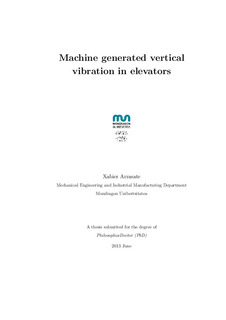
Ikusi/
Izenburua
Machine generated vertical vibration in elevatorsEgilea
Irakurtze Data
2013-06-19Eskubideak
© Xabier Arrasate AyerbeSarbidea
Sarbide irekiaArgitaratzailearen bertsioa
https://doi.org/10.48764/1ghq-rw52Argitaratzailea
Mondragon Unibertsitatea. Goi Eskola PoliteknikoaGako-hitzak
Tecnología de los sistemas de transporteLaburpena
Vertical vibration deteriorates passenger comfort during an elevator travel. The drive system is a source of vertical vibration as well as the source of energy of the system. This report presents the ... [+]
Vertical vibration deteriorates passenger comfort during an elevator travel. The drive system is a source of vertical vibration as well as the source of energy of the system. This report presents the results of a study of car vertical vibrations generated at the drive system in elevator installations. The elevator system can be considered as a translating assembly of inertia elements coupled and constrained by one-dimensional slender continua. The inertia elements are the car assembly, the counterweight, the traction sheave and other rotating components of the system. According to the roping arrangement and to the ratio of the tangential velocity of the traction sheave to the velocity of the car, the traction elevators can be classified as roped 1:1 or multiple reeving systems: the types examined in the present work are 1:1 and 2:1 traction elevators. Distributed- and lumped-parameter models (DPM and LPM respectively) are developed to calculate the natural frequencies and mode shapes of stationary elevator systems and their results compared. A non-stationary model of a 1:1 roping configuration elevator is developed as well to simulate the elevator acceleration response. The model accommodates the drive system dynamics: it includes the electric motor and the torque and velocity controllers, which ensure that the car follows a prescribed kinematic profile, so that good ride quality of the elevator is achieved. The machine parameters are computed by means of the Finite Element Method simulation software FLUX. With respect to the carcounterweight-sheave-ropes assembly, a LPM and a novel DPM are developed. The elevator dynamics represented by the DPM is described by a partial differential equation set that is discretised by expanding the vertical displacements in terms of the linear stationary mode shapes of a system composed of three masses constrained by the suspension rope. The models are implemented in the MATLAB/Simulink computational environment and the system response is determined through numerical simulation. It is shown that the LPM forms a good approximation of the DPM. Experimental tests are carried out on laboratory models. The elasticity modulus of the rope and the friction coefficients at the guide rail contact and at the machine are estimated. The acceleration response at the suspended masses and at the drive machine, the machine shaft velocity and the three phase current intensities supplied to the machine are measured during several travels. The machine torque is estimated from the current intensities. The computed and measured accelerations are compared either in time or frequency domain and it is demonstrated that the elevator car vibrates at frequencies generated at the machine, especially when they are close to the system natural frequencies. The proposed simulation models can be used as design and analysis tools in the development of high-performance elevator systems. [-]
Bildumak
- Tesiak - Ingeniaritza [229]
Item honek honako baimen-fitxategi hauek dauzka asoziatuta:






















